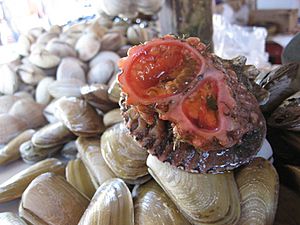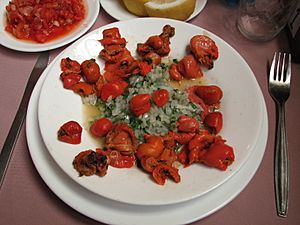Pyura chilensis facts for kids
Quick facts for kids Pyura chilensis |
|
|---|---|
 |
|
| Piure on a bed of clams, harvested in the Valparaíso Region | |
| Scientific classification | |
| Synonyms | |
|
Pyura chilensis, also known as piure in Spanish, is a unique sea creature. It belongs to a group of animals called tunicates. These creatures often look like a mass of organs inside a rock. The piure was first described in 1782 by a person named Juan Ignacio Molina.
Contents
Discovering the Piure
The first time Pyura chilensis was written about was in 1782. This was done by Juan Ignacio Molina in his book. Molina was a Chilean abbot, which is a type of religious leader. He wrote his book to describe life in Chile. He mentioned how much the local people loved fishing. He also wrote about the piure as a food source for them.
What is a Piure?
The piure looks a bit like a group of organs inside a rock. You can often find many of them together. They live on the coast of Chile and Peru. They are found in areas that are sometimes covered by water and sometimes not.
A piure is a filter feeder. This means it eats by sucking in seawater. It then filters out tiny living things, called microorganisms, from the water.
Piure Life Cycle
When a piure is born, it is male. As it grows up, it becomes both male and female. This is called being hermaphroditic. It reproduces by releasing sperm and eggs into the water. If a piure is all alone, it can even fertilize itself.
The blood of a piure is clear. It can have a lot of a metal called vanadium. There can be ten million times more vanadium in its blood than in the seawater around it. Scientists do not yet know why this is or what the vanadium does.
Fishing for Piure
Along the coast of Chile, many piure are caught. The piure is also a main food for other sea animals. One example is the Chilean abalone. These abalones have grown so much that they have threatened the piure.
Many local people put on wet suits and goggles. They dive to collect the piure. They usually find them in rocky areas near the shore. Sometimes they go farther out to sea to find them.
Fishermen usually cut the piure into pieces with a saw. Then they use their fingers to pull out the soft parts. These parts are called siphons. The hard outer shell is thrown away. The soft meat is often sold in strips. It can also be put into cans. Piure is sent to many countries. In 2007, Sweden and Japan were big buyers.
Cooking with Piure

The meat of the piure has a very strong flavor. You can eat it raw or cooked. Some people say it tastes like iodine. Others describe it as tasting like a sea urchin, but stronger. It can also have a slightly bitter or soapy taste.
People usually cut the piure into small pieces. They often add chopped onion, cilantro, and lemon for flavor. When minced and boiled, it is used in many dishes. A popular dish is "rice with minced piure." You can also fry it and eat it on bread.
There are some concerns about eating piure. This is because of the high amount of vanadium it contains. Vanadium is a heavy metal. It can be harmful in large amounts. The average diet usually has only tiny amounts of vanadium. Scientists are still studying how much vanadium is in piure meat. They are also looking into how much of it people might get from eating piure dishes. More studies are needed to understand this fully.
See also
 In Spanish: Piure para niños
In Spanish: Piure para niños


